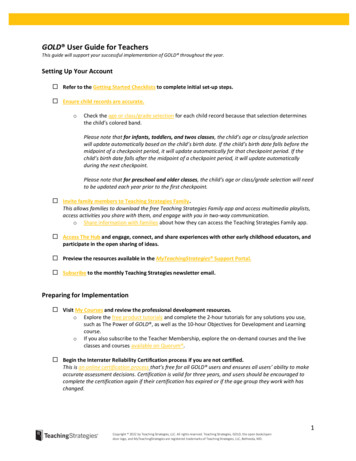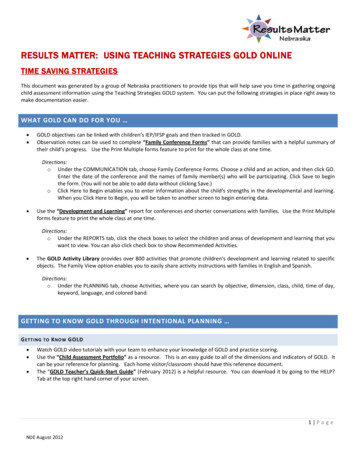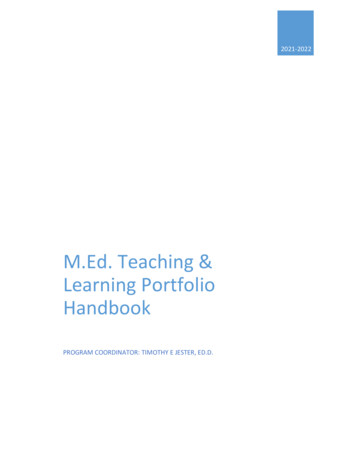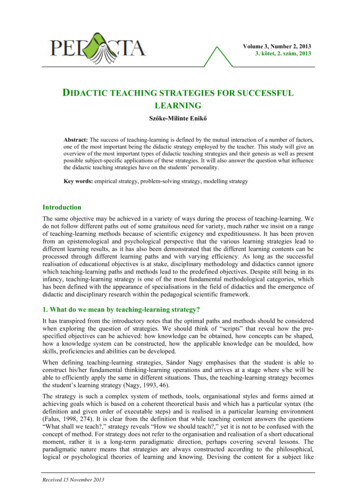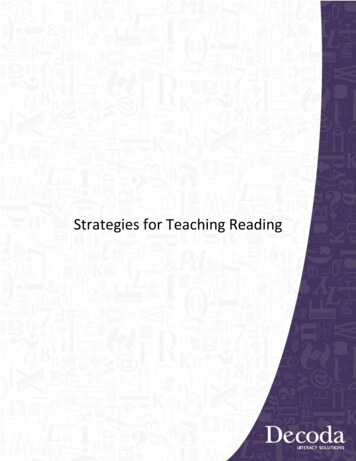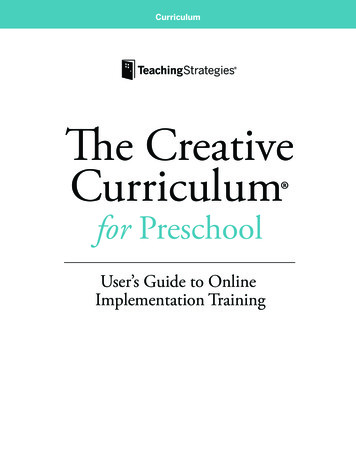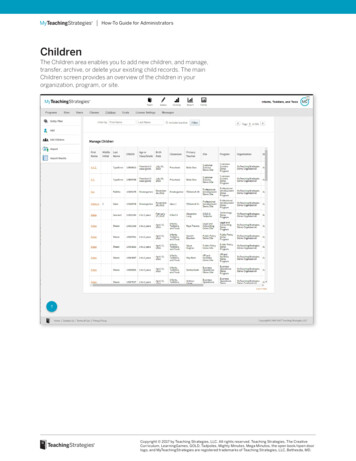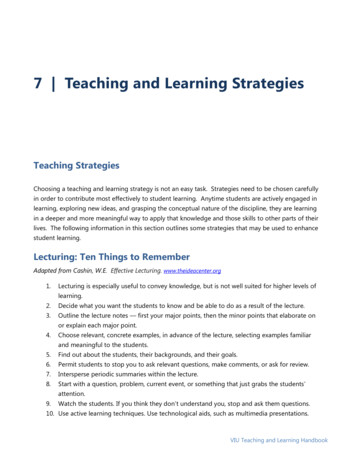
Transcription
7 Teaching and Learning StrategiesTeaching StrategiesChoosing a teaching and learning strategy is not an easy task. Strategies need to be chosen carefullyin order to contribute most effectively to student learning. Anytime students are actively engaged inlearning, exploring new ideas, and grasping the conceptual nature of the discipline, they are learningin a deeper and more meaningful way to apply that knowledge and those skills to other parts of theirlives. The following information in this section outlines some strategies that may be used to enhancestudent learning.Lecturing: Ten Things to RememberAdapted from Cashin, W.E. Effective Lecturing. www.theideacenter.org1.Lecturing is especially useful to convey knowledge, but is not well suited for higher levels oflearning.2.Decide what you want the students to know and be able to do as a result of the lecture.3.Outline the lecture notes — first your major points, then the minor points that elaborate onor explain each major point.4.Choose relevant, concrete examples, in advance of the lecture, selecting examples familiarand meaningful to the students.5.Find out about the students, their backgrounds, and their goals.6.Permit students to stop you to ask relevant questions, make comments, or ask for review.7.Intersperse periodic summaries within the lecture.8.Start with a question, problem, current event, or something that just grabs the students’attention.9.Watch the students. If you think they don’t understand you, stop and ask them questions.10. Use active learning techniques. Use technological aids, such as multimedia presentations.VIU Teaching and Learning Handbook
ngTeaching and Learning Strategy Definition and ExamplesThe Direct instruction strategy is highly teacher-directed and is among the most commonly used. This strategy is effective for providinginformation or developing step-by-step skills. It also works well for introducing other teaching methods, or actively involving students inknowledge construction.Possibilities Include: Lecture, Slide Presentation, Explicit Teaching, Drill and Practice, Didactic Questions, Demonstrations, Guided andShared – reading, listening, viewing thinking, Guest Lecture, Video, Multimedia PresentationInteractive instruction relies heavily on discussion and sharing among participants. Students can learn from peers and teachers to developsocial skills and abilities, to organize their thoughts, and to develop rational arguments. The interactive instruction strategy allows for arange of groupings and interactive methods. It is important for the teacher to outline the topic, the amount of discussion time, thecomposition and size of the groups, and reporting or sharing techniques. Interactive instruction requires the refinement of observation,listening, interpersonal, and intervention skills and abilities by both teacher and students.Possibilities Include: Debates, Role Playing, Panels, Brainstorming, Peer Partner Learning, Peer Assessment, Discussion, Laboratory Groups,Labs, Think/Pair/Share, Co-operative Learning, Jigsaw, Problem Solving, Tutorials, Interviewing, Conferencing, Team-Based Learning, SeminarsIn contrast to the direct instruction strategy, indirect instruction is mainly student-centered, although the two strategies can complementeach other. Indirect instruction seeks a high level of student involvement in observing, investigating, drawing inferences from data, orforming hypotheses. It takes advantage of students' interest and curiosity, often encouraging them to generate alternatives or solveproblems. In indirect instruction, the role of the teacher shifts from lecturer/director to that of facilitator, supporter, and resource person.Possibilities Include: Problem Solving, Case Studies, Reading, Inquiry, Reflective Discussion, Writing, Concept Formation, Concept Mapping,TutorialsIndependent study refers to the range of instructional methods which are purposefully provided to foster the development of individualstudent initiative, self-reliance, and self-improvement. While independent study may be initiated by student or teacher, the focus here willbe on planned independent study by students under the guidance or supervision of a classroom teacher. In addition, independent studycan include learning in partnership with another individual or as part of a small group.Possibilities Include: Essays, Computer Aided Instruction, Journals, Learning Logs, Reports, Learning Contracts, Homework, ResearchProjects, Assigned Questions, Learning Centres, Independent Project/Course, Self-AssessmentExperiential learning is inductive, learner centered, and activity oriented. Personalized reflection about an experience and the formulation ofplans to apply learning to other contexts are critical factors in effective experiential learning. The emphasis in experiential learning is on theprocess of learning and not on the product.Possibilities Include: Field Trips, Narratives, Conducting Experiments, Simulations, Games, Storytelling, Field Observations, Role-Playing,Model Building, Surveys, Studio Labs, Community Engaged Learning, Study Abroad, Community Service Learning, Undergraduate Research,Internships, Practicum, Co-op Placement, Apprenticeship, Field Courses2 Teaching and Learning Strategies
Teaching For Improved Student Metacognitive LearningPhoto Credit: Krissy Venosdale /Metacognition: Purposefully thinking about one’s own thinking strategies – when studentsare able to “learn to think” and “think to learn”Three critical steps to teaching metacognition1. Teaching students that their ability to learn is mutable2. Teaching planning and goal-setting3. Giving students ample opportunities to practice monitoring their learning and adapting asnecessary“[I]t is terribly important that in explicit and concerted ways we make students aware ofthemselves as learners. We must regularly ask, not only ‘What are you learning?’ but ‘How are youlearning?’ We must confront them with the effectiveness (more often ineffectiveness) of theirapproaches. We must offer alternatives and then challenge students to test the efficacy of thoseapproaches.” (Weimer, 2012)Tips for Fostering Metacognition1.Formative Assessment: Classroom assessment techniques that are short, reflective andprovide feedback on learning e.g., The Muddiest Point—Giving students practice inidentifying confusions: “What was most confusing to me about the material explored inclass today?”2.Visual Representation of Course/Class: Diagram, flowchart, concept map of coreconceptsVIU Teaching and Learning Handbook
3.Employ Active Reading: Guiding questions for readings, ‘test’ on key concepts next dayor via online quiz, have students teach each other what read, focus attention on solving aproblem4.Teach in Multiple Ways with Choice :Offer learning experiences that tap into a varietyof modes of learning – we all learn through multi-modal ways and need to experience avariety (choice is good too) ways of coming at learning of a new topic5.Exam or Lecture Wrappers: Questions, surveys or discussions afterlearning/tests/activities have taken place that focus on the learning and not the evente.g., take up a test as to how students studied, prepared, took the test, hardestquestions, easiest questions6.Self-Assessments: Prior knowledge of performance on a task – do pre post!7.Reflective Writing Activities: On in class activities, readings, videos, class presentationse.g., most important point learned from reading, most valued learning and integratingreflection into course work: integrate short reflections (oral or written) that ask studentswhat they found challenging or what questions arose during anassignment/exam/project8.In Class Feedback on Learning: Best way to support learning provide immediatefeedback e.g., clickers/polling, minute papers, ticket out door, surveys, group discussionson learning9.Students Creating Questions: Have studentsdesign possible test or exam questions onreadings, content, lessons – but also supply theanswers.10. Portfolio Development: Students build aportfolio of their work and reflect on it. Learningis about the progress made and the focus onhow they learned than what they learned11. Model Metacognition: Think-aloud to share with students how you process a problemfor example: model the thinking processes involved in your field and sought in yourcourse by being explicit about “how you start, how you decide what to do first and thennext, how you check your work, how you know when you are done”4 Teaching and Learning Strategies
12. Learning Logs: Student accounts of how learning is going in a class, may read a coupleof times a term: “What about my exam preparation worked well that I should rememberto do next time? What did not work so well that I should not do next time or that Ishould change?”13. Online Forums for Processing Learning : Allows students to post pictures, snapshots oftheir best learning experiences, tips for sharing how to learn etc.14. Retrospective Post-assessment: Pushing students to recognize conceptual change:“Before this course, I thought evolution was Now I think that evolution is .” or “How ismy thinking changing (or not changing) over time?”15. Teach Metacognitive Note-Taking Skills: Beginning of Class: Help organize lesson(learning outcomes; connections to last class/other learning – Middle of Class: Remind torecord ah-ha moments, write questions, confusions from class in notes – End of Class:Suggest students draw a line after notes and consider “most important ideas”, “whatrelates to previous learning”, “where do I need to go and get help”, “most interestinglearning from class”“A teacher who is attempting to teach without inspiring the [student] with adesire to learn is hammering on a cold iron.”― Horace MannCreating Dialogue in the ClassroomDr. Stephen Rader, (Chemistry) and Dr. Tracy Summerville (Political Science), UNBCReprinted with permission by William J. Owen, Editor, 2010 UNBC Teaching ManualOne of the most important goals – and greatest challenges – of educators is to create a learningenvironment in which the students participate actively in their education by becoming engagedwith the course material. An effective way to promote active participation is through dialogue inthe classroom. Unfortunately, many students, trained by years of passive education and cowedby the fear of making mistakes, are extremely reluctant to enter into dialogue in the classroom.So, how do you get students to begin to actively engage in substantive dialogue? We argue thatthe essential pre-requisite for classroom dialogue is an atmosphere of trust.VIU Teaching and Learning Handbook
Types of DialogueQuestion and Answer (Q and A)Q and A sessions are undoubtedly the most common way in which we expect to create dialoguein the classroom. Instructors can invite students to ask questions at any time during the lectureor set aside a specific time for questions. The choice to allow students to interrupt duringlectures, however, will help in building an active learning environment because students canengage with the instructor throughout the lecture. It is also important to remember that theinstructor can ask questions of the students too.Think / Pair / ShareThink / pair / share is a technique that allows students to interact with a peer to work out aproblem or question that the instructor has assigned. Students are asked to work with a partnerin order that the students can actively work through problems. Think / pair / share works in largeclassroom settings because students can simply turn to their neighbour to begin this exercise.However, large classes also have their drawbacks because it is often difficult to ensure thatstudents are actually discussing the problem and not last night‘s party.Small Group DiscussionsSmall group discussions also work to create interaction between peers. Again, this may be anopportunity to get students to work through a single problem or for the instructor to designdifferent problems for each group. The instructor may have each group share their findings withthe whole class at the end of the discussion.Informal DebatesInformal debates may begin in a classroom quite unexpectedly. They should be encouraged andthe instructor should take the time to discuss the debate, outlining the different positionsincluding flaws in reasoning, incorrect assumptions or facts. Make sure the students understandthat free flowing debate is not tangential to lecture material. Some students assume that theonly ―voice that matters is that of the instructor. Take the time to point out how students mayhave used ideas / concepts from the course to argue a point.Formal DebatesFormal debates are a good tool to get students engaged in both careful research andpresentation techniques. The competitive nature of debate can often spark student interest. Theinstructor needs to set out the debate rules, to expect that research is done beforehandpreferably demonstrated through an assignment given to the instructor before the debate. Onetechnique for ensuring that students take the debate seriously is to ask that students dressappropriately on debate day.6 Teaching and Learning Strategies
PresentationsIndividual and group presentations are good tools to teach the important skill of oralcommunication. For some students presentations are a joy; for others presentations are wroughtwith anxiety and fear. There are two vital parts of a presentation, first there must be clear, wellresearched content and second, they must be organized and clear. It is important to helpstudents understand that presentations cannot be all ―bells and whistlesǁ without substance.Instructors may want to ask the students to design the grading rubric for the presentations.Students are likely to put the emphasis on the content when they are asked ―what makes agood presentationǁ. A presentation may have lots of bells of whistles but if the content is lost orunclear the audience will feel that they have not learned anything.Oral examinationsOral examinations can be a very effective way of determining whether or not the students canarticulate ideas they have learned in the course. It becomes very clear that a student has donethe course readings when you are having a one-on-one discussion with them about the course.When the exam is designed as an open ended interview session with a number of criticalquestions along the way, the instructor can often gauge what aspects of the course had themost impact on the student. Two notes of caution: first, it is necessary to have a grading rubrictemplate that is completed at the end of each exam otherwise it is very difficult to rememberindividual student responses; second, it is necessary to mix up the questions so that students donot share the exam questions. This also means that the instructor has to be very clear aboutwhat the students should be getting out of the course (i.e. what is examinable) so that there isno basis for students to say that they got ―hard questions whereas others got ―easy ones.Edward Zlotkowski. “Pedagogy and Engagement.” in Robert G. Bringle, Richard Games and Reverend EdwardA. Malloy eds. Colleges and Universities as Citizens .Needham Heiths, MA: Allyn & Bacon, 1999:99-100.Should you mark class participation?It is tempting to include a class participation mark as ameans of encouraging dialogue. There are twoproblems with this that merit serious consideration:first, can you and will you evaluate participation fairly,and, second, does a mark (i.e. a threat) promote thekind of active engagement you are seeking? Studentsoften pay more attention to how you mark them thanto the course content, so if you are marking classparticipation ―in your head - or as a subjectiveimpression of who contributes, they will resent it and even suspect you of favoritism.Consequently, if you wish to mark class participation, you need to have an explicit rubric (e.g. 1VIU Teaching and Learning Handbook
point for each question asked in class, 2 points for each correct answer, etc), and to have clearwritten records of who did what in each class. In other words, you will be spending a significantamount of class time noting who is talking and assigning marks to it.The second point is perhaps even more important: what kind of classroom atmosphere do youwant to promote? Do you want an engaged community of learners who are not afraid tocontribute and who are thinking about the course material and what is interesting about it? It isdifficult to achieve this when students feel coerced into something that they are not comfortabledoing. They may be distracted by the pressure and the tension, and so actually become lessengaged with the material. And, of course, the students who are really uncomfortable will notparticipate anyway, and will therefore be penalized to no effect.Encouraging Student Participation: Why It Pays to Sweat theSmall StuffA recent classroom observation reminded me that student participation can be encouraged andsupported by attention to small but important presentational details. In this article I havehighlighted these details in the form of questions, and I hope that you’ll use them to reflect onthe behaviors you’re using when seeking, listening, and responding to student contributions.How often do you ask a question and when do you ask it? How often does depend on theteacher but there’s evidence from more than one study that a lot of us over estimate how oftenwe ask questions. How often should you seek student contributions? More than you do? Do youask after you’ve covered a chunk of content and are thinking about how much you still have toget through? Do you ask at the end of the period when a lot of students are hoping nobodysays anything so they can get out a couple of minutes early?How long do you wait? How much time passes after you’ve solicited input before you move onor offer some verbal follow up? There’s research here too, and the findings are pretty consistent.Most faculty wait somewhere between two and three seconds before they do something else—ask the question again, call on somebody, rephrase the question, answer the questionthemselves, or decide nobody has anything to say and move on. When asked, most faculty claimthat they wait 10 to 12 seconds. Time passes slowly when you’ve asked a question and there’sno sign of a response—it’s an awkward, uncomfortable time for the teacher and the students.But waiting longer has its rewards.See more by Maryellen Weimer at: uf8 Teaching and Learning Strategies
4 Teaching and Learning Strategies 3. Employ Active Reading: Guiding questions for readings, 'test' on key concepts next day or via online quiz, have students teach each other what read, focus attention on solving a problem 4. Teach in Multiple Ways with Choice :Offer learning experiences that tap into a variety of modes of learning - we all learn through multi-modal ways and need to .
